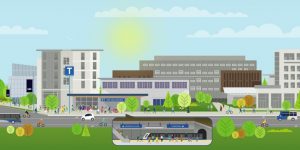Project Summary:
Our team initially wanted to focus on the greenhouse gas emissions of the 99 B-line, ran by an articulated diesel bus, along the Broadway corridor versus the greenhouse gas emissions of the UBC Line modelled to the newest Skytrain station to the east, formerly called the 'Evergreen extension'.However, we are unable to execute this project due to unavailable data and mapping complexities when we are racing against time. Subsequently, our project shifted to analyzing the social implications of the Commercial-Broadway station extension into the University of British Columbia (UBC) campus. Specifically focusing on any observable trends between the cost of housing within the 'Broadway Subway' buffer zone and the volume of transit ridership within the study area.
Team Organization:
During the first two meetings, we chose our topic and brainstormed all possible research questions. We chose to analyze and map out the proposed UBC Line along the Broadway corridor and we decided to focus on what could be the most impactful issue that may arise in the construction of this new Skytrain extension for Broadway residents. We all worked together to collect data sources, relevant news articles, TransLink and UBC statements, and transit evaluation reports. For the next meetings, one person mapped out the proposed UBC Line while the other two does the background research for these routes and data information to ensure accuracy and minimize errors. When error arises, we all troubleshoot the problem together. There are constantly at least two people working together at the same time wherein one person maps while the other writes the methodology and oversees the map coding.
For writing our report, we divided the section heads equally. Every teammate should be able to produce one table under appropriate sections. Since the ‘Discussion and Results’ section is the biggest bulk of the report, we divided the writing into three wherein every person writes at least 500 words to make the 1,500-word mark.
Learning Process:
I have only read a couple of news articles relating to the UBC Line (Broadway Subway extension) months before I decided to take on this project, I have always wanted to learn more about the project and its possible implications to the socio-economic sphere of Vancouver city. I want to know how the city of Vancouver will develop the UBC line:
- Will it be underground or aboveground? And if it is above ground, will it be extending over buildings just like much of Millennium and Expo line?
- Will this new line really reduce carbon emissions including the train’s production and road construction? If so, by how much carbon emissions are we saving per year?
- There are contradictory articles about real estate prices along the Broadway corridor. While the city of Vancouver states that housing will become more affordable, since there are more people expanding East due to ease of commuting, some articles express their concern over the increase in real estate prices. This increase may be due to the city of Vancouver looking into balancing their budget cost through expensive real estate levies imposable on newly built high-rises, which will most likely be situated in the highly desirable Broadway location. One case study we looked into this project is the “Living City”, which will be developed at Oakridge center- right beside Canada line’s Oakridge stop.
My team and I have honed our ‘Select By Attribute’ skills and created a new layer from these selections because we had to do it many times for our first map, which took the longest time to create. We have also mastered the art of finding relevant open and limited source data in Canadian Census Analyser, Abacus Dataverse Network, and City of Vancouver: Open Data Catalogue. At some points, we only found tabular data such as the Vancouver bus stops so we used Join Tables to incorporate our data into one of our Shapefile layers. Finally, we learned how to make more aesthetically-pleasing maps and more importantly, how to change layout view from portrait to landscape- we find that it is a two-step process, not just one.
The only data issues that came up were from our initial project proposal, where we could not find any available data for the greenhouse gas emissions of 99 B-line nor of any of the rapid transit lines (e.g. Millennium line, Expo line, Canada line). Additionally, it was difficult to find any greenhouse gas emissions from general Vancouver transportation, at least in open source data or through UBC library access.
